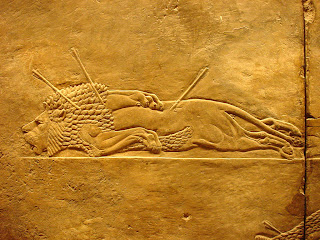War & Refugees.
The Assyrians were a tough people whose kingdom/empire came to power for a time in the mideast between the Babylonians and the Persians. The British Museum has—in addition to the great five-legged Assyrian sphinxes, which Maurice and Scudder puzzle over during their duel of wills in E. M. Forster’s Maurice--several rooms full of relief carvings from Assyrian palaces. The Assyrians were big into carving marble walls in this way. I went on a little guided walking tour of the Assyrian rooms while I was in the museum, led by a charming docent, who was mostly interested in the artistry involved in the depictions of battle. It’s true, no World War II movie was ever as visceral or visually exciting as these Assyrian carvings, which (like King Den’s sandal label or Rameses II’s sculpture) are propaganda emphasizing the enormous power of the Assyrians. I particularly like how, in the battle reliefs, you see birds flying away from the battlefield with corpses and body parts; it’s all very “Ride of the Valkyries.” And, on an earlier trip to the British museum, I was also struck by the room full of Assyrian reliefs about lion hunting.
Behold our mighty king...
...how he doth vanquish the wretched foe.
But what interested MacGregor the most, on his podcast, was the depiction of refugees. The Assyrian reliefs tell a story, left to right, across a long wall: the armies go to war, there’s a terrific battle, carnage and destruction and scavenger birds, and then long lines of prisoners are marched past the conquering king. In this case--the Lachish reliefs--the prisoners are Hebrews, and the story of this battle is told from the other point of view in the Old Testament. (Needless to say, the two versions of the story don’t agree on exactly what happened, each version trying to make its protagonists look good.)
A lady in my little tour group asked whether this was the story behind Verdi’s Nabucco, probably because these Assyrian reliefs are often used in publicity for traditional productions of the opera. I happen to know a lot about the origins of Nabucco (a pair of French playwrights wrote a play in the 1830s, loosely based on King Lear, which then inspired a ballet at La Scala in Milan; the cheap impresario had Temistocle Solera write a libretto on the subject because the impresario wanted to reuse the sets and costumes he had had built for the ballet. He offered Solera’s libretto to Otto von Nicolai, who wrote Die Lustigen Weiber von Windsor, and when Nicolai declined to compose the opera the impresario gave it to young Verdi. The Lear-themes and the refugee-themes captured his imagination, and a mighty career was launched), and so pressed for clarification on the differences between the Babylonians and the Assyrians. My sense is, the Assyrians were more badass, but I’m sure scholars spend a lifetime sorting out the differences--they overlap in time and location (I think the Assyrians were over a little earlier, and were a bit to the west). In any event, Giuseppe Verdi loved depicting MacGregor’s story, the human suffering of the chorus full of refugees. The three great Verdi choruses that leap into my mind are the opening of Don Carlos, where he starts with the suffering of the refugees because that’s going to dominate the choices made in the interpersonal drama by the principal characters later on; the awesomely potent and sad “Patria oppressa!” chorus from the revised Macbeth; and the very scene in this relief, captive prisoners being carted out in front of the conquering king, in the Triumphal March sequence in Aida.



No comments:
Post a Comment